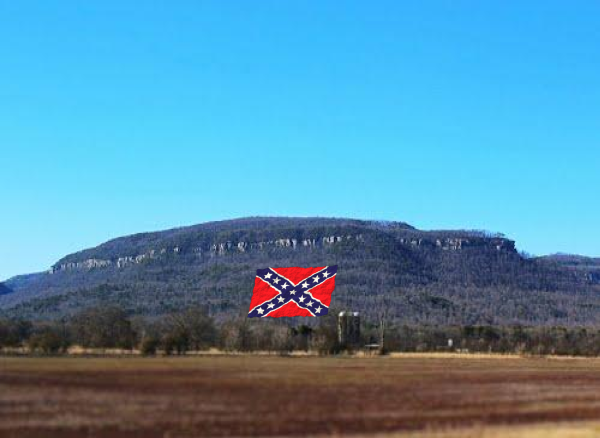DUNLAP TN MAN WANTS TO PUT REBEL FLAG MONUMENT ON SIDE OF FREDONIA MT.
 A former Dunlap mayor wants to create what could be the largest image of the Confederate battle flag in the South to preserve what he says is an important part of American history and his own heritage.
A former Dunlap mayor wants to create what could be the largest image of the Confederate battle flag in the South to preserve what he says is an important part of American history and his own heritage.
The Chattanooga Times Free Press reports that Carson Camp wants to use the side of Fredonia Mountain in the pastoral Sequatchie Valley to paint the flag, which would be as large as two football fields.
Camp’s family owns several hundred acres on the Cumberland Plateau, including a portion of one of the Trail of Tears routes onto the plateau.
Camp, who is also a coal mining historian, said the idea for the flag monument came about when he and his son were discussing the impact of the recent fatal shooting of nine people at a black church in South Carolina. The white suspect, 21-year-old Dylann Storm Roof, posed in photos displaying Confederate flags.
The violent rampage sparked renewed debate over the flag. Many southern politicians have called for its removal from statehouses and license plates, and retailers such as Walmart and Amazon stopped selling it.
Some Tennessee lawmakers want a bust of Nathan Bedford Forrest — rebel general, slave trader and early Ku Klux Klan member — to be removed from the state Capitol, and plans to remove Forrest’s statue and gravesite from a Memphis, Tenn., park are moving forward.
“My son said, ‘What can we do to stop this? They’re taking down every symbol of the South,'” said Camp, who is a member of the Sons of Confederate Veterans, and has Confederate battle flags and memorabilia scattered throughout his home.
“I said, ‘If we wanted to there’s nothing that tells me we can’t go up there and clean out 10 acres and put the world’s biggest Confederate flag up.'”
Camp said Roof’s actions were “horrible,” but connecting the Confederate symbol with the suspect’s own racist agenda is unfair to history and those with historic family ties to the Confederacy.
Camp said his great-great-grandfather, R.C. Camp, was 14 when he joined the Confederate Army and served in the cavalry under Forrest. R.C. Camp was captured in 1863 and sent to a Union prison camp in Chicago. He survived and returned to Sequatchie County, where he died in 1922.
NAACP Chattanooga chapter president Dr. Elenora Woods said the issue comes down to considering one another’s feelings and emotions alongside their historic experience.
“You’ve got two different life experiences. The life experience of African-Americans is different when you talk about the time upon which the Confederate flag was waved,” Woods said.
“It was a terrible time. But for those who were fighting for slavery, that’s the flag they waved. So if your life experience, or the window you’re looking out of was not the window that said, ‘I am a slave,’ you might not have a problem with it.”
Camp said the grid for the flag would be laid out using global positioning satellites, and it would be built from stones painted in red, white and blue water-based paint.
Dunlap Mayor Dwain Land defended Camp’s freedom of speech and said the small town of Dunlap could benefit economically from Camp’s plans.
“It’s his property, he can do what he wants,” Land said. “From an economic standpoint, if it turns out to be a sightseeing site like Mount Rushmore or Stone Mountain, Ga., it’ll be a benefit for Dunlap.”


